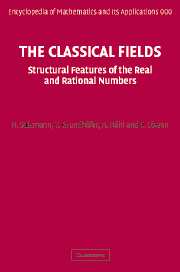4 - Completion
Published online by Cambridge University Press: 07 May 2010
Summary
In Chapter 1, the basic properties of the real numbers were taken for granted. In Chapter 3, devoted to the rational numbers, we sometimes used the fact that they are embedded in the real numbers. In the present chapter, we shall discuss standard procedures which allow us to construct the domain of real numbers from the domain of rational numbers by so-called completion. (A non-standard procedure was already presented in Section 23.)
The rational numbers are not complete, either with respect to their ordering (there are non-empty bounded sets which have no supremum within the rational numbers), or as a topological group (there are Cauchy sequences of rational numbers which do not converge to a rational number). Completion processes remedy these defects by a cautious enlargement which supplies the missing suprema or limits, without introducing new incompleteness problems. Corresponding to the two facets of incompleteness of the rational numbers, there are two types of completion, one for ordered structures and, more specifically, for ordered groups, and another one for certain topological structures, in particular for topological groups. These completion principles will be presented here. (We do not, however, discuss completion of metric spaces or, more generally, of uniform spaces without algebraic structure.)
For the rational numbers, both kinds of completion, the completion of ℚ as an ordered group and its completion as a topological group, will lead to the same mathematical object (up to isomorphism), the additive group ℝ of real numbers, with its ordering and its topology.
Information
- Type
- Chapter
- Information
- The Classical FieldsStructural Features of the Real and Rational Numbers, pp. 235 - 277Publisher: Cambridge University PressPrint publication year: 2007
